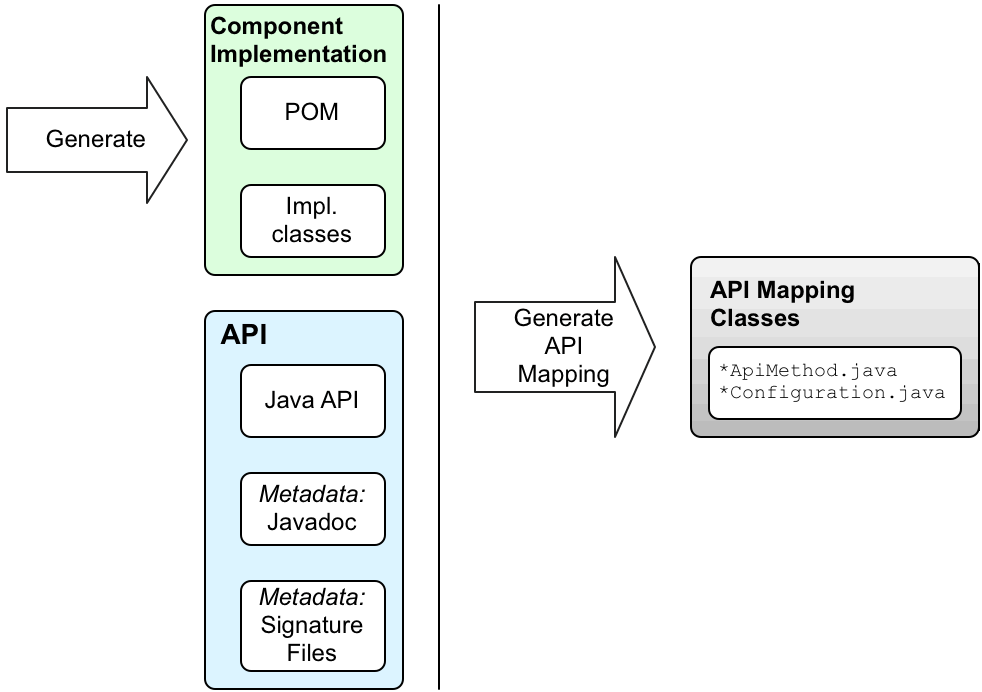Fuse 6 is no longer supported
As of February 2025, Red Hat Fuse 6 is no longer supported. If you are using Fuse 6, please upgrade to Red Hat build of Apache Camel.此内容没有您所选择的语言版本。
54.2. How to use the Framework
Overview
复制链接链接已复制到粘贴板!
The procedure for implementing a component using the API framework involve a mixture of automated code generation, implementing Java code, and customizing the build, by editing Maven POM files. FIG gives an overview of this development process.
Figure 54.1. Using the API Component Framework
Java API
复制链接链接已复制到粘贴板!
The starting point for your API component is always a Java API. Generally speaking, in the context of Camel, this usually means a Java client API, which connects to a remote server endpoint. The first question is, where does the Java API come from? Here are a few possibilities:
- Implement the Java API yourself (though this typically would involve a lot of work and is generally not the preferred approach).
- Use a third-party Java API. For example, the Apache Camel Box component is based on the third-party Box Java SDK library.
- Generate the Java API from a language-neutral interface. For example, the Apache Camel LinkedIn component obtains its Java API by converting a WADL description of its REST services to Java (using the Apache CXF
wadl2javatool).
Javadoc metadata
复制链接链接已复制到粘贴板!
You have the option of providing metadata for the Java API in the form of Javadoc (which is needed for generating code in the API component framework). If you use a third-party Java API from a Maven repository, you will usually find that the Javadoc is already provided in the Maven artifact. But even in the cases where Javadoc is not provided, you can easily generate it, using the
maven-javadoc-plugin Maven plug-in.
Note
Currently, there is a limitation in the processing of Javadoc metadata, such that generic nesting is not supported. For example,
java.util.List<String> is supported, but java.util.List<java.util.List<String>> is not. The workaround is to specify the nested generic type as java.util.List<java.util.List> in a signature file.
Signature file metadata
复制链接链接已复制到粘贴板!
If for some reason it is not convenient to provide Java API metadata in the form of Javadoc, you have the option of providing metadata in the form of signature files. The signature files consist of a list of method signatures (one method signature per line). These files can be created manually and are needed only at build time.
Note the following points about signature files:
- You must create one signature file for each proxy class (Java API class).
- The method signatures must not include a
raisesclause. All exceptions raised at runtime are wrapped in aRuntimeCamelExceptionand returned from the endpoint. - Class names that specify the type of an argument must be fully-qualified class names (except for the
java.lang.*types). There is no mechanism for importing package names. - Currently, there is a limitation in the signature parser, such that generic nesting is not supported. For example,
java.util.List<String>is supported, whereasjava.util.List<java.util.List<String>>is not. The workaround is to specify the nested generic type asjava.util.List<java.util.List>.
The following shows a simple example of the contents of a signature file:
public String sayHi(); public String greetMe(String name); public String greetUs(String name1, String name2);
public String sayHi();
public String greetMe(String name);
public String greetUs(String name1, String name2);Generate starting code with the Maven archetype
复制链接链接已复制到粘贴板!
The easiest way to get started developing an API component is to generate an initial Maven project using the
camel-archetype-api-component Maven archetype. For details of how to run the archetype, see Section 55.1, “Generate Code with the Maven Archetype”.
After you run the Maven archetype, you will find two sub-projects under the generated
ProjectName directory:
ProjectName-api- This project contains the Java API, which forms the basis of the API component. When you build this project, it packages up the Java API in a Maven bundle and generates the requisite Javadoc as well. If the Java API and Javadoc are already provided by a third-party, however, you do not need this sub-project.
ProjectName-component- This project contains the skeleton code for the API component.
Edit component classes
复制链接链接已复制到粘贴板!
You can edit the skeleton code in
ProjectName-component to develop your own component implementation. The following generated classes make up the core of the skeleton implementation:
ComponentNameComponent ComponentNameEndpoint ComponentNameConsumer ComponentNameProducer ComponentNameConfiguration
ComponentNameComponent
ComponentNameEndpoint
ComponentNameConsumer
ComponentNameProducer
ComponentNameConfigurationCustomize POM files
复制链接链接已复制到粘贴板!
You also need to edit the Maven POM files to customize the build, and to configure the
camel-api-component-maven-plugin Maven plug-in.
Configure the camel-api-component-maven-plugin
复制链接链接已复制到粘贴板!
The most important aspect of configuring the POM files is the configuration of the
camel-api-component-maven-plugin Maven plug-in. This plug-in is responsible for generating the mapping between API methods and endpoint URIs, and by editing the plug-in configuration, you can customize the mapping.
For example, the following
camel-api-component-maven-plugin plug-in configuration shows a minimal configuration for an API class called ExampleJavadocHello:
In this example, the
hello-javadoc API name is mapped to the ExampleJavadocHello class, which means you can invoke methods from this class using URIs of the form, scheme://hello-javadoc/endpoint. The presence of the fromJavadoc element indicates that the ExampleJavadocHello class gets its metadata from Javadoc.
OSGi bundle configuration
复制链接链接已复制到粘贴板!
The sample POM for the component sub-project,
ProjectName-component/pom.xml, is configured to package the component as an OSGi bundle. The component POM includes a sample configuration of the maven-bundle-plugin. You should customize the configuration of the maven-bundle-plugin plug-in, to ensure that Maven generates a properly configured OSGi bundle for your component.
Build the component
复制链接链接已复制到粘贴板!
When you build the component with Maven, the
camel-api-component-maven-plugin plug-in automatically generates the API mapping classes (which define the mapping between the Java API and the endpoint URI syntax), placing them into the target/generated-classes project subdirectory. When you are dealing with a large and complex Java API, this generated code actually constitutes the bulk of the component source code.
When the Maven build completes, the compiled code and resources are packaged up as an OSGi bundle and stored in your local Maven repository as a Maven artifact.
